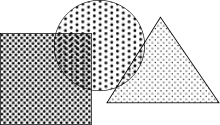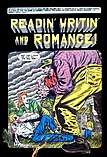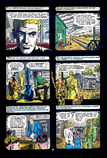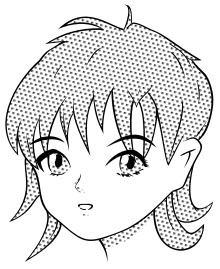Screentone
Screentone is a technique for applying textures and shades to drawings, used as an alternative to hatching. In the conventional process, patterns are transferred to paper from preprinted sheets,[1] but the technique is also simulated in computer graphics, notably in Flipnote Studio and Macpaint. It is also known by the common brand names Zip-A-Tone (1937, now defunct[2]), Chart-Pak (1949[3]), and Letratone (1966, from Letraset[4]).

A traditional screentone sheet consists of a flexible transparent backing, the printed texture, and a wax adhesive layer. The sheet is applied to the paper, adhesive down, and rubbed with a stylus on the backing side. The backing is then peeled off, leaving the ink adhered to the paper where pressure was applied.
Motivation


A screentone saves an artist's time by allowing quick application of textures to line art where a hand-shaded area would not be reproduced in a timely or acceptable manner. Much like halftone, the size and spacing of black dots, lines, or hatches determine how light or dark an area will appear. Visual artists need to take into account how much an image will be reduced when prepared for publication when choosing the pitch of a screentone. Screentones can also be layered to produce interference patterns such as moire effects, or to simulate multiple sources of shadow in an image.
Styles
Different styles of screentone exist, variously intended to depict clothing, clouds, emotions, backgrounds, gradients and even objects such as trees. While the sheets are most commonly produced with black ink, there are also varieties in solid and patterned colors. Screentones can also be modified by lightly scratching the backing with an X-Acto blade to produce starbursts and other special effects.

Screentones are widely used by illustrators and artists, especially for cartoons and advertising. Use of the original medium has been declining since the advent of graphics software and desktop publishing, but it is still used, for example in manga.
While computer graphics software provides a variety of alternatives to screentone, its appearance is still frequently simulated, to achieve consistency with earlier work or avoid the appearance of computer-generated images. It is sometimes accomplished by scanning actual screentone sheets, but original vector or bitmap screen patterns are also used.
See also
Notes
- Sharon Kinsella, Adult Manga: Culture and Power in Contemporary Japanese Society, Routledge, 2000, p59. ISBN 0-7007-1003-5
- Manufacturer-supplied first use date for Zip-A-Tone
- Manufacturer-supplied first use date for Chart-Pak
- Manufacturer-supplied first use date for Letratone